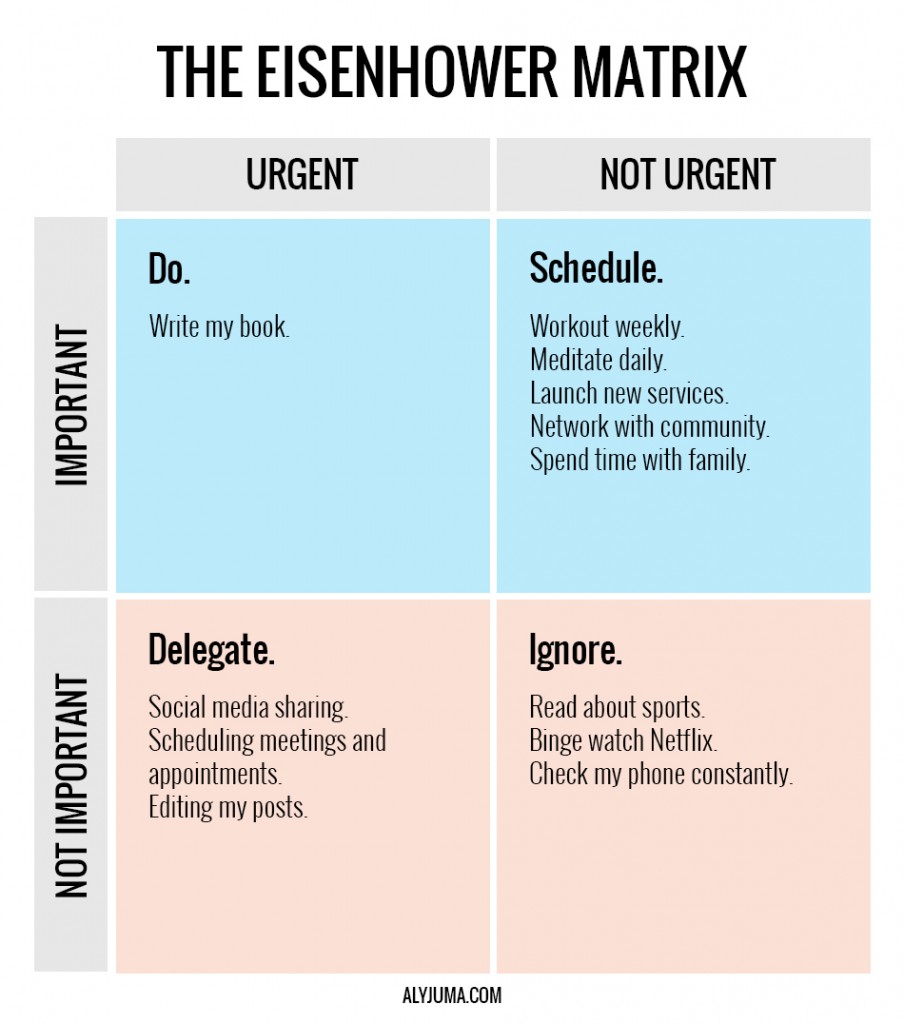Dwight D. Eisenhower is one of the most highly regarded President’s ever, having handled many crisis situations with astonishing poise. His accomplishments don’t start there though.
Before becoming the 34th President of the United States, he served as a five-star general in the U.S. Army and as the Supreme Commander of the Allied Forces in Europe during World War II.
During his tenure as President, he launched programs that directly impacted space exploration, interstate transportation, alternative energy, and our beloved internet itself.
No big deal right?
What made him such a great leader and decision maker is up for debate, but part of the credit must go to the framework he created: The Eisenhower Matrix.
What Is The Eisenhower Matrix?
The matrix was devised by Eisenhower as a way to prioritize tasks across two key qualities: urgency and importance. He used this method to help him make decisions and prioritize what he had to do.
Decisions can be difficult after all, especially when the outcomes of those decisions lay at your feet. Forget that I struggle with deciding what to wear some mornings, think about deciding what to do in a war or as leader of our country. My problems are small potatoes.
Even so, we all have to make decisions, and they are often rife with emotion, uncertainty, and consequence. It only makes sense to have a framework that can enable you to make the best decisions, without being overwhelmed by external factors.
The Eisenhower Matrix is a framework that can help you do exactly that. Here’s how it works.
How to use the matrix?
The Eisenhower Matrix consists of four separate quadrants that are defined as follows: Do, Schedule, Delegate, Ignore.
Quadrant 1: Do
The items in the Do quadrant are both urgent and important. They take priority over everything else. This could be as basic as making progress on your business venture to as extreme as family emergencies or deadlines.
The first quadrant is at the top of your to do list, but that also means it should be a short list. Ideally you only have one item in the first quadrant, the most important task of the day.
Everything is NOT urgent and important, so try to be honest with yourself when deciding what this is.
Quadrant 2: Schedule
The Schedule quadrant consists of items that are important, but not urgent. You want to do them, they matter to your life, but the world won’t end if you don’t get them done today.
As such, they are best suited to be scheduled during your days and weeks, to ensure that you keep up with them as needed. These are things like morning routines, workouts, family time, meetings with clients and so on.
They matter, but they are not necessarily time sensitive, despite how much we may make them feel that way.
A few things to keep in mind with items in this quadrant. First, try to avoid the recency effect, where the latest disaster becomes the focus of your attention. Stick to your schedule, don’t be reactive.
Second, having an endless list of items to schedule can be overwhelming. You again need to be honest with yourself on how important the items in this quadrant really are.
Quadrant 3: Delegate
The Delegate quadrant is made up of items that are urgent, but not important, which means they should be delegated. Unfortunately, these are the things we often spend the most time on and make us feel busy.
Examples of these include running errands, not saying no when you truly should (aka helping everyone but yourself), and dealing with small fires that have nothing to do with you. Even things as simple as scheduling appointments, booking travel, paying bills, and more could all be delegated, whether that’s to another person or to technology.
If you do some digging, you can discover how you can automate a lot of your life, by simply creating the right systems and delegating these items to others.
Quadrant 4: Ignore
Finally you get the items that you simply shouldn’t be doing. The Ignore quadrant is made up of items that are not important and not urgent.
We all know what these are, despite us indulging in them now and then. Things like social media, tv, video games, shopping, and gambling all fall in this category. Look at where you’re wasting time in your day and what you can do to change those behaviors.
While putting these activities on a list won’t solve all your problems, it will make you more aware of when you’re doing them and hopefully begin to shift your habits away from them.
General Tips
The Eisenhower Matrix can be a powerful tool if used correctly. These are some general tips that can make your experience with it that much easier.
Eliminates Before You Optimize
A key to using the matrix is that you eliminate before you optimize. Look at what you could put on the list and cull it down before you try to organize it. How do you do this?
You need to assess every item in terms of your long term goals and personal mission. What matters to you? What are you working towards? If they don’t bring you closer towards your goals, they’re probably not needed in the first place.
Keep Tasks Manageable
Making a to do list helps keep your mind at ease, as you know it’s not forgotten. That being said, you can’t let your list get out of hand. For the Eisenhower Matrix to be effective, you shouldn’t have 10, 20, or 30 items in any list. Keep things manageable.
A good rule of thumb is to keep items in each quadrant at 8 tasks or less, otherwise you’re not really getting any value out of the framework.
Use These Resources
You can easily create the framework in a notebook and track it that way or you can leverage technology. I created a simple template in Google Sheets that you can download here and use for your own matrix.
Alternatively, if you’re a fan of Trello, it can be fairly easy to setup a board that works in much the same way. Pro tip: have an incoming list of items that either get sorted into a quadrant or cut altogether.

You can find more great resources at: http://www.eisenhower.me/
Review Your Matrix Regularly
Finally, it’s important to make a habit of reviewing your matrix. I find it’s best to check it out before bed, so that you can reflect on your day, but also prime yourself for what is to come tomorrow.
However you do it, the key is to keep it organized and manageable.
What is important is seldom urgent and what is urgent is seldom important.Dwight D. Eisenhower
Eisenhower achieved a lot during his time and the matrix certainly had some role to play. It provides a rigid structure for making decisions and prioritizing your day.
If you’re struggling with staying on task or feel overwhelmed with things to do, you should give it a shot and see if it works for you.

